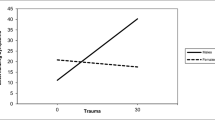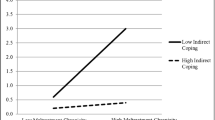Abstract
The current study examined the interactive influence of multiple factors (i.e., physical abuse severity and negative affectivity) in predicting youth’s inpatient psychiatric length of stay (LOS), extending previous research focused on identification of only single LOS predictors. Elevated physical abuse severity was hypothesized to predict longer youth LOS, and negative affectivity was anticipated to exacerbate this relationship. This study included 42 youth. Clinicians rated youth temperament, whereas physical abuse severity and LOS were coded from youth medical records. Controlling for other previously determined predictors of LOS (i.e., age, gender, and GAF), moderation analyses confirmed hypotheses, revealing a temperament by environment interaction. Specifically, physical abuse severity was positively associated with LOS only in the context of high negative affectivity. Findings highlighted the importance of disentangling the interactive effects of multiple factors in predicting LOS. Moreover, critical clinical implications involving prioritized trauma assessment and treatment for inpatient youth are discussed.

Similar content being viewed by others
References
Hussey DL, Guo S (2005) Forecasting length of stay in child residential treatment. Child Psychiatry Hum Dev 36:95–111
Blanz B, Schmidt MH (2000) Preconditions and outcome of inpatient treatment in child and adolescent psychiatry. J Child Psychol Psychiatry 41:703–712
Mechanic D, McAlpine DD, Olfson M (1998) Changing patterns of psychiatric inpatient care in the United States, 1988–1994. Arch Gen Psychiatry 55:785–791
Green J, Jacobs B (1998) Current challenges. In: Green J, Jacobs B (eds) In-patient child psychiatry: modern practice, research, and the future. Routledge, London, pp 3–8
Pottick KJ, Hansell S, Miller JE, Davis DM (1999) Factors associated with inpatient length of stay for children and adolescents with serious mental illness. Soc Work Res 23:213–225
Stroul B, Friedman R (1986) A system of care for children and youth with severe emotional disturbances. Georgetown University Child Development Center, National Technical Assistance Center for Children’s Mental Health, Washington, DC
Hersov L (1994) Inpatient and day hospital units. In: Rutter M, Taylor E, Hersov L (eds) Child and adolescent psychiatry: modern approaches. Blackwell, Oxford, pp 9993–9995
Causey DL, McKay M, Rosenthal C, Darnell C (1998) Assessment of hospital-related stress in children and adolescents admitted to a psychiatric inpatient unit. J Child Adolesc Psychiatr Nurs 11:135–145
Cohen LJ (1994) Psychiatric hospitalization as an experience of trauma. Arch Psychiatr Nurs 8:78–81
Fleck MP, Wagner L, Wagner M, Dias M (2007) Long-stay patients in a psychiatric hospital in Southern Brazil. Rev Saude Publica 41:124–130
Patrick C, Padgett DK, Burns BJ, Schlesinger HJ (1993) Use of inpatient services by a national population: do benefits make a difference? J Am Acad Child Adolesc Psychiatry 32(1):144–152
Borchardt CM, Garfinkel BD (1991) Predictors of length of stay of psychiatric adolescent inpatients. J Am Acad Child Adolesc Psychiatry 30:994–998
Gold J, Shera D, Clarkson B (1993) Private psychiatric hospitalization of children: predictors of length of stay. J Am Acad Child Adolesc Psychiatry 32:135–143
Pavkov TW, Goerge RM, Czapkowicz JG (1997) Predictors of length of stay among youths hospitalized in state hospitals in Illinois. J Child Fam Stud 6:221–231
Saravay SM, Lavin M (1994) Psychiatric comorbidity and length of stay in the general hospital: a critical review of outcome studies. Psychosomatics 35:233–252
Stellwagen KK, Kerig PK (2010) Relation of callous-unemotional traits to length of stay among youth hospitalized at a state psychiatric inpatient facility. Child Psychiatry Hum Dev 41:251–261
Mason MA, Gibbs JT (1992) Patterns of adolescent psychiatric hospitalization: implications for social policy. Am J Orthopsychiatry 62:447–457
Compton MT, Craw J, Rudisch BE (2006) Determinants of inpatient psychiatric length of stay in an urban county hospital. Psychiatr Q 77:173–188
McLay RN, Daylo A, Hammer PS (2005) Predictors of length of stay in a psychiatric ward serving active duty military and civilian patients. Mil Med 170:219–222
Pottick K, Hansell S, Gutterman E, White HR (1995) Factors associated with inpatient and outpatient treatment for children and adolescents with serious mental illness. J Am Acad Child Adolesc Psychiatry 34:425–433
Sourander A, Korkeilia J, Turunen M (1998) Factors related to length of psychiatric hospital stay of children and adolescents: a nationwide register study. Nord J Psychiatry 52:373–378
Tulloch AD, Fearon P, David AS (2011) Length of stay of general psychiatric inpatients in the United States: systematic review. Adm Policy Ment Health, Ment Health Serv Res 38:155–168
Bettmann JE, Jasperson RA (2009) Adolescents in residential and inpatient treatment: a review of the outcome literature. Child Youth Care Forum 38:161–183
Briere J, Elliott DM (2003) Prevalence and psychological sequelae of self-reported childhood physical and sexual abuse in a general population sample of men and women. Child Abuse Negl 27:1205–1222
Lansford JE, Dodge KA, Pettit GS, Bates JE, Crozier J, Kaplow J (2002) A 12-year prospective study of the long-term effects of early child physical maltreatment on psychological, behavioral, and academic problems in adolescence. Arch Pediatr Adolesc Med 156:824–830
Shipman KL, Zeman J (2001) Socialization of children’s emotion regulation in mother–child dyads: a developmental psychopathology perspective. Dev Psychopathol 13:317–336
Teisl M, Cicchetti D (2008) Physical abuse, cognitive and emotional processes, and aggressive/disruptive behavior problems. Soc Dev 17:1–23
MacMillan HL, Fleming JE, Streiner DL, Lin E, Boyle MH, Jamieson E, Duku EK, Walsh CA, Wong MY, Beardslee WR (2001) Childhood abuse and lifetime psychopathology in a community sample. Am J Psychiatry 158:1878–1883
Rothbart MK, Bates JE (2006) Temperament. Wiley, Hoboken
Gartstein MA, Bridgett DJ, Low CM (2012) Asking questions about temperament: self- and other-report measures across the lifespan. In: Zentner M, Shiner RL (eds) Handbook of temperament. Guilford Press, New York
Bates JE (1990) Conceptual and empirical linkages between temperament and behavior problems: a commentary on the Sanson, Prior, and Kyrios study. Merrill Palmer Q 36:193–199
Brody GH, Stoneman Z, Burke M (1988) Child temperament and parental perceptions of individual child adjustment: an intrafamilial analysis. Am J Orthopsychiatr 58:532–542
Caspi A, Henry B, McGee RO, Moffitt TE (1995) Temperamental origins of child and adolescent behavior problems: from age three to fifteen. Child Dev 66:55–68
Paulussen-Hoogeboom MC, Stams G, Hermanns J, Peetsma T, Van Den Wittenboer G (2008) Parenting style as a mediator between children’s negative emotionality and problematic behavior in early childhood. J Genet Psychol 169:209–226
Enns MW, Cox BJ, Inayatulla M (2003) Personality predictors of outcome for adolescents hospitalized for suicidal ideation. J Am Acad Child Adolesc Psychiatry 42:720–727
Frick PJ, Morris AS (2004) Temperament and developmental pathways to conduct problems. J Clin Child Adolesc Psychol 33:54–68
Lengua LJ, Wachs TD (2012) Temperament and risk: resilient and vulnerable responses to adversity. In: Zentner M, Shiner RL (eds) Handbook of temperament. Guilford Press, New York
Wachs TD (1992) The nature of nurture. Sage, Newbury Park
Wachs TD (2006) Contributions of temperament to buffering and sensitization processes in children’s development. Ann NY Acad Sci 1094:28–39
Gallagher KC (2002) Does child temperament moderate the influence of parenting on adjustment? Dev Rev 22:623–643
Morris AS, Silk JS, Steinberg L, Sessa FM, Avenevoli S, Essex MJ (2002) Temperamental vulnerability and negative parenting as interacting of child adjustment. J Marriage Fam 64:461–471
Blackson TC, Tarter RE, Mezzich AC (1996) Interaction between childhood temperament and parental discipline practices on behavioral adjustment in preadolescent sons of substance abusing and normal fathers. Am J Drug Alcohol Abuse 22:335–348
Leve LD, Kim HK, Pears KC (2005) Childhood temperament and family environment as predictors of internalizing and externalizing trajectories from ages 5 to 17. J Abnorm Child Psychol 33:505–520
Barnett D, Manly JT, Cicchetti D (1993) Defining child maltreatment: the interference between policy and research. In: Cicchetti D, Toth S (eds) Child abuse, child development and social policy. Ablex, Norwood, pp 7–73
Ellis LK, Rothbart MK (2001) Revision of the early adolescent temperament questionnaire. Poster presented at the 2001 biennial meeting of the Society for Research in Child Development, Minneapolis
Capaldi DM, Rothbart MK (1992) Development and validation of an early adolescent temperament measure. J Early Adolesc 12:153–173
Packard MA, First MB (2011) Guidelines to use of Axis V: global assessment functioning scale. New Avenues Midwest Behavioral Health Network, South Bend
Aiken LS, West SG (1991) Multiple regression: testing and interpreting interactions. Sage, Thousand Oaks
Connor DF, Miller KP, Cunningham JA, Melloni RH (2002) What does getting better mean? Child improvement and measure of outcome in residential treatment. Am J Orthopsychiatr 72:110–117
Gabel S, Shindledecker R (1990) Parental substance abuse and suspected child abuse/maltreatment predict outcome in children’s inpatient treatment. J Am Acad Child Adolesc Psychiatry 29:919–924
Sourander A, Helenius H, Leijala H, Heikkilä T, Bergroth L, Piha J (1996) Predictors of outcome of short-term child psychiatric inpatient treatment. Eur Child Adolesc Psychiatry 5:75–82
Sourander A, Helenius H, Piha J (1996) Outcome of short-term child psychiatric hospitalization: teacher evaluation at 5-month and 12-month follow-up. Eur Child Adolesc Psychiatry 5:204–211
Robertson BA, Friedberg S (1979) Follow-up study of children admitted to a psychiatric day centre. S Afr Med J 56:1129–1131
Connor-Smith J, Jaser SS (2004) Temperament, stress reactivity, and coping: implications for depression in childhood and adolescence. J Clin Child Adolesc Psychol 33:21–31
Thomas JM (1995) Traumatic stress disorder presents as hyperactivity and disruptive behavior: case presentation, diagnoses, and treatment. Infant Ment Health J 16:306–317
Weinstein D, Staffelbach D, Biaggio M (2000) Attention-deficit hyperactivity disorder and posttraumatic stress disorder: differential diagnosis in childhood sexual abuse. Clin Psychol Rev 20(3):359–378
Barbe R, Bridge JA, Birmaher B, Kolko DJ, Brent DA (2004) Lifetime history of sexual abuse, clinical presentation, and outcome in a clinical trial for adolescent depression. J Clin Psychiatry 65:77–83
Lewis CC, Simons AD, Nguyen LJ, Murakami JL, Reid MW, Silva SG, March JS (2010) Impact of childhood trauma on treatment outcome in the treatment for adolescents with depression study (TADS). J Clin Child Adolesc Psychol 49:132–140
Pottick K, Hansell S, Gaboda D, Gutterman E (1993) Child and adolescent outcomes of inpatient psychiatric services: a research agenda. Child Youth Serv Rev 15:371–384
Author information
Authors and Affiliations
Corresponding author
Rights and permissions
About this article
Cite this article
Comas, M., Valentino, K., Bridgett, D.J. et al. The Direct and Interactive Effects of Physical Abuse Severity and Negative Affectivity on Length of Psychiatric Hospitalization: Evidence of Differential Reactivity to Adverse Environments in Psychiatrically High-Risk Youth. Child Psychiatry Hum Dev 45, 220–228 (2014). https://doi.org/10.1007/s10578-013-0394-6
Published:
Issue Date:
DOI: https://doi.org/10.1007/s10578-013-0394-6




